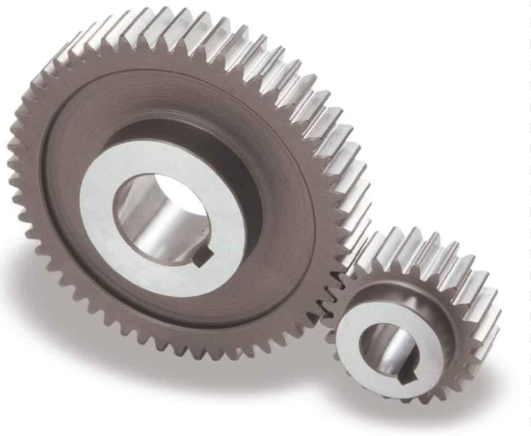Gears are crucial in machines, allowing for efficient motion and power transfer. Spur gears, known for their simple and fundamental design, are the most commonly used type in mechanical systems.
Their straightforward design is responsible for their common use in engineering and everyday devices, offering numerous applications and benefits. Nevertheless, they also have limitations, particularly under high-speed or heavy-load conditions.
In this article, we examine spur gears, examining their defining features, operational principles, and typical applications, alongside their advantages and inherent limitations, to provide a comprehensive understanding of their role in various scenarios.
What Is a Spur Gear?
A spur gear is a cylindrical gear with teeth that are straight and parallel to the axis of rotation. It is designed to mesh with other spur gears to transmit motion and power between two parallel shafts.
Their simplicity in design makes them easy to manufacture and cost-effective. Depending on the application and the operational environment, they are usually made from steel, brass, plastic, or cast iron.
Their teeth, which are evenly spaced around the circumference, ensure smooth and consistent power transmission. This straightforward design distinguishes spur gears from other types of gears, such as helical or bevel gears.
Features of Spur Gears
Straight Teeth
The most recognizable feature of a spur gear is its straight and parallel teeth, which allow it to engage seamlessly with another spur gear on a parallel shaft.
Simple Construction
Spur gears consist of a central hub and a toothed rim, making their design uncomplicated and easy to produce.
Material Versatility
Spur gears can be crafted from various materials to suit different operational needs, from high-strength steel for industrial machinery to lightweight plastics for household appliances.
Efficiency
Their direct contact between teeth minimizes energy loss during power transmission, resulting in high efficiency.
Ease of Maintenance
The simplicity of their design makes spur gears easy to inspect, repair, or replace when necessary.
How Spur Gears Work to Transfer Motion
The working principle of spur gears is straightforward. When one gear’s teeth mesh with the teeth of another gear, rotational motion is transferred from one shaft to the other. The driving gear (input) applies force to the driven gear (output), resulting in synchronized rotation.
The speed and torque of the output gear depend on the gear ratio, which is determined by the number of teeth on each gear as envisioned by the spur gear manufacturer. For example, if the driving gear has 20 teeth and the driven gear has 40 teeth, the gear ratio is 2:1. The output gear will rotate at half the speed of the input gear but with twice the torque.
Common Applications of Spur Gears in Everyday Machines
Spur gears are ubiquitous in modern machinery. Their versatility and efficiency make them suitable for a wide range of applications, including:
Clocks and Watches
Spur gears are foundational in timekeeping devices. They transfer motion from the mainspring to the hands of the clock or watch through a series of interlocking gears.
Automotive Systems
In vehicles, spur gears are used in gearboxes for smooth transitions between speeds and in steering systems to convert the steering wheel’s rotational movement into the lateral motion needed to turn the wheels. Additionally, they are used in windshield wipers to translate the motor’s rotation into an oscillating motion.
Industrial Machinery
Spur gears are indispensable in conveyors and mixers used to blend substances consistently because they can handle repeated motion and torque, which is essential for mixing ingredients thoroughly.
Appliances
Many household devices, such as washing machines and blenders, rely on spur gears to operate efficiently. In washing machines, spur gears help rotate the drum and blenders use spur gears to translate motor power into high-speed rotation.
Robotics
Spur gears in robotic systems facilitate precise motion control and torque transmission. Whether controlling the arm movement of a robotic assembly line unit or allowing a robotic vehicle to navigate obstacles, spur gears ensure the accurate transfer of power and motion.
Power Tools
Tools like drills and saws often incorporate spur gears due to their straightforward and efficient design. In drills, spur gears convert the motor’s output into the rotary motion necessary for driving screws or boring holes.
Advantages and Limitations of Spur Gears
Advantages
- Simplicity: Spur gears boast a straightforward design, making them easy to manufacture, understand, and maintain.
- Cost-Effective: Their uncomplicated construction results in lower production costs.
- High Efficiency: Direct tooth engagement ensures minimal power loss and efficient energy transfer.
- Material Versatility: They can be made from various materials, enabling customization for specific applications.
- Precision: They provide accurate motion transfer, which is crucial for precise devices like clocks and measuring instruments.
Limitations
- Noise: They can become noisy at high speeds due to abrupt tooth engagement.
- Load Capacity: They are less suitable for heavy loads and high speeds, as their teeth can wear down.
- Alignment Sensitivity: Requires precise alignment to prevent tooth damage and maintain smooth operation.
- Limited Orientation: They connect only parallel shafts, restricting use in complex gear systems.
Conclusion
Spur gears, renowned for their simple yet effective design, are integral to many mechanical systems. Their efficiency, manufacturing ease, and versatility make them essential in industrial and everyday applications.
However, recognizing their limitations is key to selecting the appropriate gear for each task. From clocks to cars and industrial machines, spur gears exemplify engineering simplicity. By balancing their merits and constraints, engineers can maximize the potential of these fundamental gear components.


